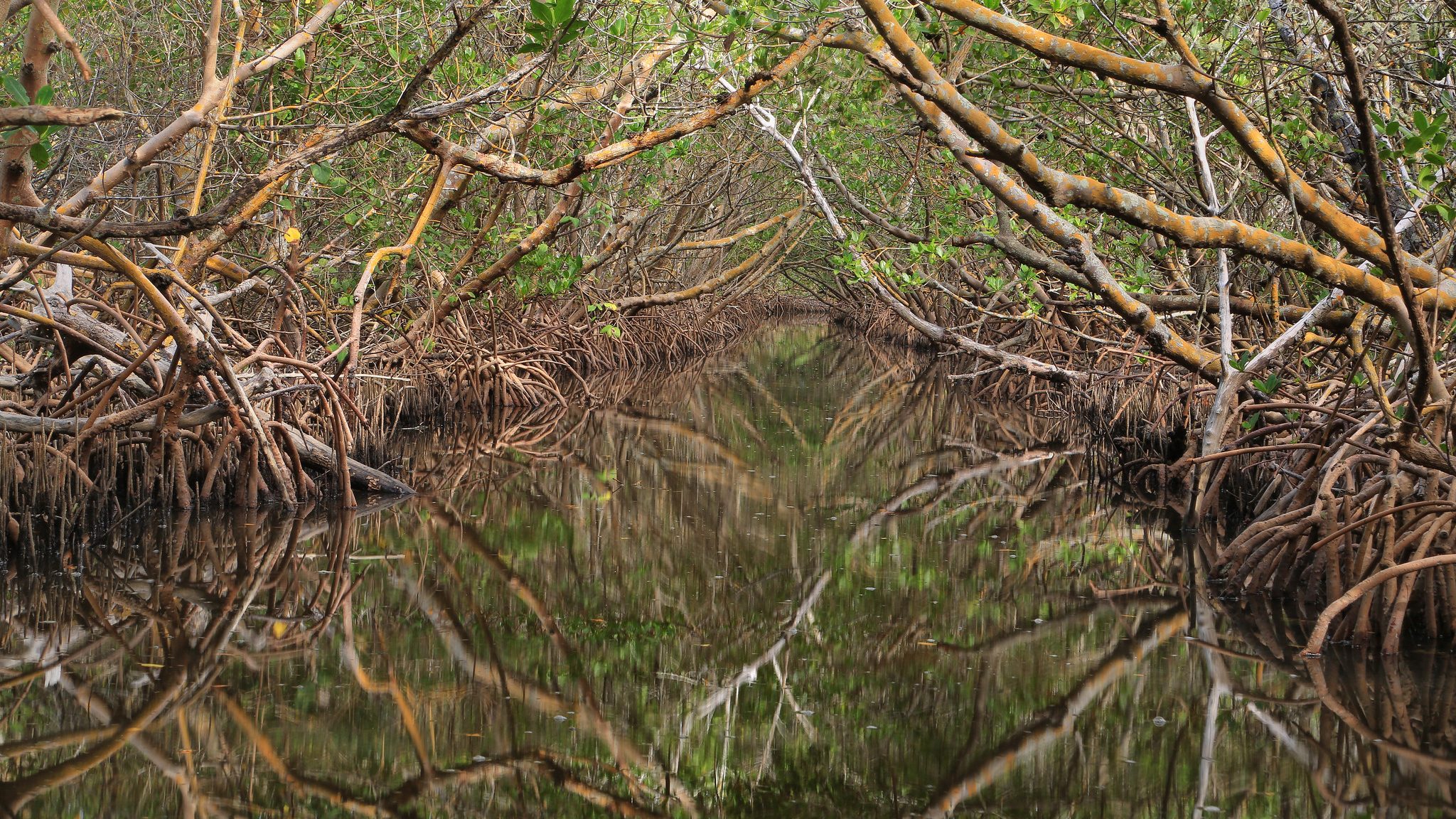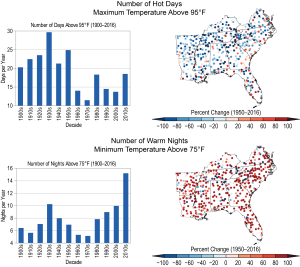Overview: What is the NCA4 and what does it mean for the Southeast?

Fourth National Climate Assessment (NCA4) Webinar Series
This six-part webinar series is designed to help our partners and stakeholders in the Southeast more readily access the large amount of information synthesized in the Fourth National Climate Assessment Volume II (NCA4). This overview will introduce some of the important messages from NCA4, connect you directly to related elements of the volume, and make connections to relevant research, publications, and data from the SE CASC and others. We’ve also developed some pdf versions of NCA4 figures, for ease of downloading for your purposes.
Below is a brief overview of Chapter 19: Southeast.
In a later post, we will provide a brief overview of Chapter 15: Tribes and Indigenous Peoples and Chapter 20: U.S. Caribbean.
Overview
The National Climate Assessment (NCA) is a scientific assessment, federally mandated by the Global Change Research Act of 1990, which evaluates current and projected climate change related effects across all regions of the United States every four years. NCA4 Volume II: Impact, Risks, and Adaptation in the United States (NCA4) was released in November 2018, building on the NCA4 Volume I: Climate Science Special Report (CSSR), published in 2017. CSSR provides in-depth information on the foundational physical science of climate change upon which much of the assessment of impacts in Volume II is based. NCA4 also builds on concerns described in the 2014 Third National Climate Assessment.
What Has Happened Since the Last National Climate Assessment?
NCA4 reflects increased understanding of and experience with the relationship between climate impacts, science, risks, and adaptation in the United States. It incorporates key scientific advances in the following areas: a) detection and attribution of weather events to human influence, b) climate change effects on extreme events and atmospheric circulation, c) finer-scale climate modeling for localized information, e.g. State Climate Summaries, d) impacts on ocean and coastal waters, e) measurements of rapid changes in ice cover on earth, and f) potential for surprises in the climate system, such as feedbacks and tipping points. Get more detail about these scientific advances here.
Quick Links:
• NCA4 Volume I: Climate Science Special Report • Vol. I Executive Summary
• NCA4 Volume II: Impact, Risks, and Adaptation • Vol. II Executive Summary
• Chapter 19 – Southeast • Chapter 20 – U.S. Caribbean
• FAQS
A glossary of terms used in NCA4 is available on the USGCRP website.
Ch. 19: Southeast

The Southeast has experienced massive population growth, containing 12 of the 20 fastest-growing cities in the United States. While this increase in development is shown to contribute to climate change risks, it also represents an increase in capacity and resources to adapt to these problems.
NCA4 Figure 19.1 depicts the average increase in the number of hot days and warm nights in the Southeast from 1950-2016. Additionally, 61% of major Southeast cities have experienced an increase in heat waves, the highest observed increase compared to other regions in the U.S.
NCA4 builds on the concerns listed below from NCA3:
• Sea Level Rise
• Increasing temperatures
• Extreme heat events
• Heavy precipitation
• Decreased water availability
As the occurrence of these concerns increases in the Southeast, the following key impacts are becoming more visible:
• Flooding increases stress on infrastructure, ecosystems and populations
• Warming temperatures affect human health and also include temporal and geographic shifts shifts in the Southeast’s natural environment and landscapes
• Wildfires and growing wildfire risk create challenges for natural resource managers and communities
Historical Numbers and Figures in the Southeast:
• Historical Changes in Hot Days and Warm Nights (Link to Figure 19.1 | Downloadable PDF)
• Historical Change in Freeze-Free Season Length (Link to Figure 19.2 | Downloadable PDF)
• Historical Change in Heavy Precipitation (Link to Figure 19.3 | Downloadable PDF)
SE CASC Contributions and Relevant Projects:
The following SE CASC projects focused on downscaling climate models and monitoring of climate changes:
• Downscaling Climate Projections to Understand Future Temperature and Precipitation Patterns in the Southeast – The datasets include projections of climate variables in addition to daily temperature and precipitation such as surface winds, humidity, and solar radiation that are needed in hydrologic and ecological modeling
• Evaluating Downscaled Climate Models for Projecting Future Changes in the Southeast – Evaluates widely used downscaled climate projections covering the Southeast and recommends best practices for use of downscaled datasets for ecological modeling and decision-making.
• The Global Change Monitoring Portal – The database consolidates metadata – information about data – for measurements made by monitoring programs, and the locations where data are collected, when available.
NCA4 Key Messages for the Southeast
Below are the four Key Messages from Chapter 19 (Southeast) of NCA4, with a brief summary of the underlying details of the Key Message, evidence of the impacts identified within the Key Message, and relevant research and publications. In addition to providing direct links to the relevant figures in the online NCA4 report, we also provide downloads for figures as a resource for our readers.
Key Message 1 – Urban Infrastructure and Health Risks
“Many southeastern cities are particularly vulnerable to climate change compared to cities in other regions, with expected impacts to infrastructure and human health. The vibrancy and viability of these metropolitan areas, including the people and critical regional resources located in them, are increasingly at risk due to heat, flooding, and vector-borne disease brought about by a changing climate. Many of these urban areas are rapidly growing and offer opportunities to adopt effective adaptation efforts to prevent future negative impacts of climate change (very likely, high confidence).”
Key Message 2 – Increasing Flood Risks in Coastal and Low-Lying Regions
“The Southeast’s coastal plain and inland low-lying regions support a rapidly growing population, a tourism economy, critical industries, and important cultural resources that are highly vulnerable to climate change impacts. The combined effects of changing extreme rainfall events and sea level rise are already increasing flood frequencies, which impacts property values and infrastructure viability, particularly in coastal cities. Without significant adaptation measures, these regions are projected to experience daily high tide flooding by the end of the century (likely, high confidence).”
Key Message 3 – Natural Ecosystems will be Transformed
“The Southeast’s diverse natural systems, which provide many benefits to society, will be transformed by climate change. Changing winter temperature extremes, wildfire patterns, sea levels, hurricanes, floods, droughts, and warming ocean temperatures are expected to redistribute species and greatly modify ecosystems. As a result, the ecological resources that people depend on for livelihood, protection, and well-being are increasingly at risk, and future generations can expect to experience and interact with natural systems that are much different than those that we see today (very likely, high confidence).”
Key Message 4 – Economic and Health risks for Rural Communities
“Rural communities are integral to the Southeast’s cultural heritage and to the strong agricultural and forest products industries across the region. More frequent extreme heat episodes and changing seasonal climates are projected to increase exposure-linked health impacts and economic vulnerabilities in the agricultural, timber, and manufacturing sectors. By the end of the century, over one-half billion labor hours could be lost from extreme heat-related impacts (likely, medium confidence). Such changes would negatively impact the region’s labor-intensive agricultural industry and compound existing social stresses in rural areas related to limited local community capabilities and associated with rural demography, occupations, earnings, literacy, and poverty incidence. Reduction of existing stresses can increase resilience (very likely, high confidence).”
Notable SE CASC Contributions to NCA4
Many individuals associated with the Southeast Climate Adaptation Science Center have made contributions to the NCA4 Volume II. This includes SE CASC staff and scientists, researchers funded by SE CASC, and research affiliates of the SE CASC.
SE CASC Chapter 19 Contributors: Adam Terando, Federal Coordinating Lead Author; Kirstin Dow, Chapter Author; Aranzazu Lascurain, Chapter Author; and Michael Osland, Chapter Author
- Categories:
